Cinisi
Cinisi, a town of a little over 12,000 people just outside of Palermo, is surrounded by mountains and the Tyrrhenian Sea.
A fertile beautiful land with olive trees and lemons. it is also known for la vacca cinisara, the cows that graze the mountains.
Here’s a photo of Corso Umberto, the main street through Cinisi. The large white building at the end of the street is the Municipio.
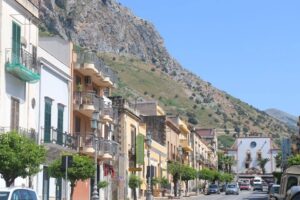
History
Although there is history of people living in the area of Cinisi back through antiquity, the 17th century is when a lot of the families who are still connected moved there.
‘Around 1610 a part of the lands of the “tenimentum” of Cinisi was granted in emphyteusis (a sort of lease allowing use of the land), attracting many families who built their homes around the new Benedictine monastery that was built by Abbot Andrea da Palermo around 1617, and gave way to development of the new village.
In the following centuries many rivalries flamed between the Monastery and the La Grua, Lords of Carini. One reason for the dispute was the question about the parish autonomy:
“Cinisi and Terrasini asked the Bishop of Mazara (…) to free them from Carini, on which they depended. Having accepted the request, the church dedicated to Santa Fara was built as Parish Church of Cinisi and Terrasini. {1}
So this is why many tracing family lineage there will see that records for their families were in Carini and/or Monreale prior to moving to Cinisi in the 1600s. That is because there was incentive or at least ability and desire to move there at that time. Many did.
In this graph, you can see the population of Cinisi back through 1861. Though its population in 2020 is likely around twice what it was in 1861, it’s interesting to see when population drops happened. i.e. Unification of Italy occurred in 1860, and most of Sicilian immigration to America took place between 1880 and 1920 as can be seen in this graph as well. {2}
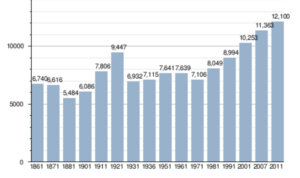
On the passenger ship record below from 1903, you can see that all 30 passengers listed on this page of this particular ship manifest were all from Cinisi. Their destinations included New York, Detroit, New Orleans, St Louis and Philadelphia. Some would have stayed in the United States; some would have worked a bit and returned to Cinisi. You can read more about emigration / immigration here.
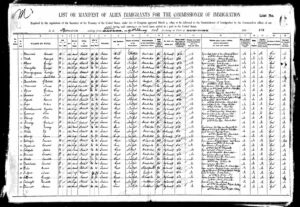
Photos Then and Now
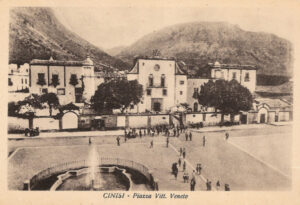
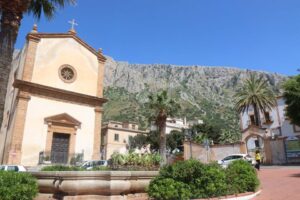
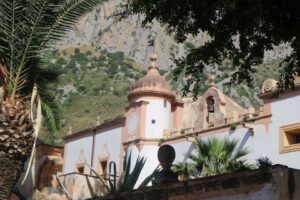

If your family traces back centuries in Cinisi, it is likely that birth and marriage records etc can be found at Santa Fara Vergine church.
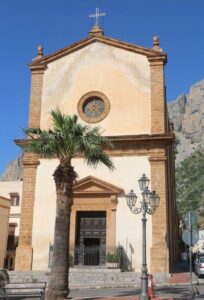
Videos
These videos help take you there if you can’t be there in person.
Santa Fara is a very active church and has some large gatherings and events. Below is a video of Festa Santa Fara with padre Don Vincenzo Gaglio and local parishioners. They talk about their patron saint and what this means to them, and the video also shows some of the procession out in the street. It’s quite elaborate and festive.
Cinisi is located very near the city of Palermo (in the province of Palermo) and is on the coast of the Tyrrhenian Sea. Spiaggia Magaggiari is its beautiful beach.
Well Known People from Cinisi
Giovanni Meli (1740-1815) studied philosophy and medicine and was a doctor in Cinisi. He was also a very well-known poet of his time. Here is one of his poems, written in Sicilian and translated to English. {3}
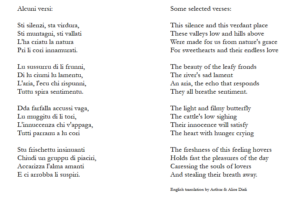
Giuseppe (Peppino) Impasto was a local anti-mafia political activist who was murdered in 1978. The film I Centi Passi (One Hundred Steps) is a movie about his life. It was filmed in Cinisi and released in 2000. You can see the movie in full with English subtitles here.
Carnevale
Cinisi is also a town with many celebrations. Carnevale is a big event every year. Here are a couple videos of it.
Random, but this next video is just for fun.
Links
http://www.comune.cinisi.pa.it/
{1} From “Centro di studi filologici e linguistici siciliani”, “Bollettino”, 1973, p. 298 as referenced at the following link: https://www.italythisway.com/places/articles/cinisi-history.php
{2} https://en.wikipedia.org/wiki/Cinisi
{3} http://dieli.net/SicilyPage/Poetry/Meli.html